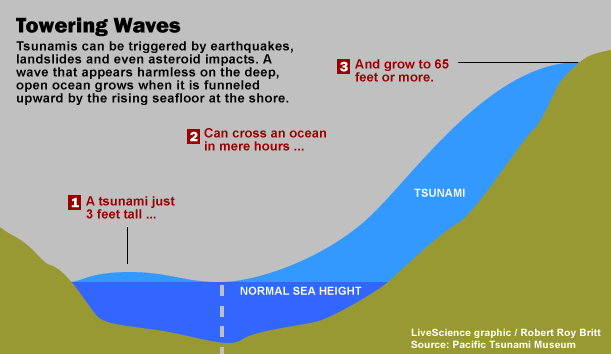Two Deadly Quakes: Is Earth Unusually Active?

Between the earthquakes that struck the Samoas and Indonesia yesterday and the temblor that devastated L'Aquila, Italy earlier this year, it might seem like Earth has been particularly shaky this year.
But that's not the case: "This is not out of the ordinary as far as the year goes," said John Bellini, a geophysicist with the U.S. Geological Survey.
While it's not unusual to have several large quakes in any given year, these rumblings of the Earth can have different profiles, occurring on different types of faults and triggering varying series of events, including tsunamis possibly even other earthquakes.
Scientists said it's possible the two quakes this week are related, but they don't know yet. Meanwhile, researchers have some preliminary explanations as to why the Samoan temblor generated a deadly tsunami but the Indonesian quake did not.
A year in earthquakes
More than a million earthquakes are estimated to shake the Earth's surface every year, though most of these are minor tremors, barely perceptible to humans if at all.
As you go up in earthquake magnitude (a measure of a quake's strength), these events become rarer: About 17 magnitude 7.0 to 7.9 quakes occur around the globe each year, while on average only one magnitude 8.0 or higher strikes over the period of a year. (The logarithmic nature of the magnitude scale means that an 8.0-magnitude quake is 10 times stronger than a 7.0-magnitude.)
Sign up for the Live Science daily newsletter now
Get the world’s most fascinating discoveries delivered straight to your inbox.
The underwater quake that struck of the coast of Samoa and American Samoa yesterday measured about 8.0, according to the USGS. The quake off the coast of Sumatra, Indonesia came in at an estimated 7.6 magnitude. (The L'Aquila quake, which struck in April, was only a 6.3-magnitude quake.)
The occurrence of all these earthquakes falls entirely within the average for a given year. "We're just having a busy week," Bellini said.
Different effects
While the Samoan earthquake generated a large tsunami that rushed ashore on the South Pacific islands, leveling towns with waves estimated to be 10 foot (3 meters) or higher and killing scores, the Indonesian quake sprouted only a small local tsunami. The shaking did most of the damage in the Indonesian event.
The damage done by a quake — and how it is done — isn't just a matter of how strong the quake is, it's "dependent on how the fault breaks," Bellini told LiveScience.
The shift in Earth's crust off the coast of Sumatra occurred at a depth of about 50 miles (80 km). The Samoa tsunami-generating quake occurred much closer to the surface at 11 miles (18 km).
"You need a shallow earthquake to generate a tsunami," Bellini said.
The type of fault that ruptures to produce the earthquake also influences whether or not a tsunami develops and how big it becomes. The Samoan quake occurred along a normal fault, where one chunk of a tectonic plate lifts upward, acting as a paddle and transferring energy to the overlying water.
But sometimes this "paddle effect" is minimal, or the fault moves side-to-side instead of up and down.
The 2004 Indian Ocean tsunami was generated by a colossal 9.3-magnitude quake. An 8.7-magnitude earthquake in 2005 originating at the same location failed to produce a tsunami. It was certainly large enough to generate one, scientists say. The exact reasons it did not remain mysterious.
Related quakes?
One curious aspect of yesterday's events is how close in time and space they occurred to each other. This proximity can fuel speculation that the first earthquake triggered the second.
"I wouldn't say it's impossible," said Leonardo Seeber, a senior researcher at Lamont-Doherty Earth Observatory in New York.
In recent decades, scientists have shown that one earthquake can trigger other seismic events far away, Seeber said.
For example, a 2008 study did find that monstrous earthquakes can trigger much smaller tremors in distant locations around the globe. Another study from last year found that so-called "earthquake doublets" — where one large quake triggers another of similar magnitude (versus aftershocks which are weaker than the original quake) — can also occur, though they are rare.
And today, a new study announced that large earthquakes could weaken faults on the other side of the world. The study found that the 2004 Indian Ocean quake had weakened California's San Andreas fault.
But, "it's not easy to prove one way or the other," Seeber told LiveScience. It's also possible that the closeness of the quakes in time was a matter of chance, "because there's enough earthquakes around" to have two occur in the same region around the same time, Seeber said.
However, it's too early for seismologists to know one way or the other, though Bellini agreed it's possible they were related. "They're on the borders of the same plate," he explained, so the stresses could have transferred down the fault.
"That's not something that can be determined overnight," Bellini said.
- Video: Earthquake Forecast
- Earthquake News, Images and Information
- Images: Deadly Earthquakes Past and Present

Andrea Thompson is an associate editor at Scientific American, where she covers sustainability, energy and the environment. Prior to that, she was a senior writer covering climate science at Climate Central and a reporter and editor at Live Science, where she primarily covered Earth science and the environment. She holds a graduate degree in science health and environmental reporting from New York University, as well as a bachelor of science and and masters of science in atmospheric chemistry from the Georgia Institute of Technology.










